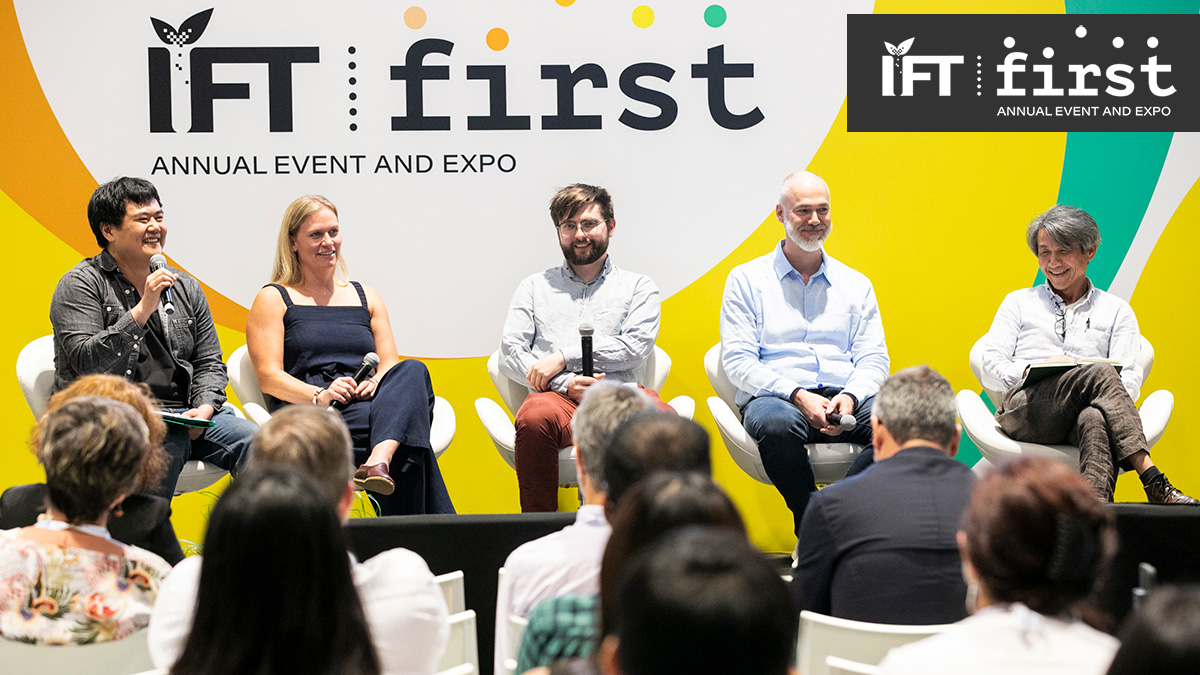The Nuts and Bolts of Food Innovation
In Monday afternoon’s Business FIRST session, four food science entrepreneurs shared their experiences in building products and businesses from their passion, creativity, and discoveries.
 There’s a growing market for innovative new food products, but getting from an idea to an in-demand product on grocery shelves is a long and often difficult process. In Monday afternoon’s Business FIRST session, “Innovators on the Edge: Pushing the Boundaries of Science to Feed a Hungry Planet,” four food science entrepreneurs shared their experiences in building products and businesses from their passion, creativity, and discoveries.
There’s a growing market for innovative new food products, but getting from an idea to an in-demand product on grocery shelves is a long and often difficult process. In Monday afternoon’s Business FIRST session, “Innovators on the Edge: Pushing the Boundaries of Science to Feed a Hungry Planet,” four food science entrepreneurs shared their experiences in building products and businesses from their passion, creativity, and discoveries.
Building a food science-based business is, for most entrepreneurs, not a one-person job. Panelists agreed that whether you have a co-founder or a team of trusted individuals, successful food science entrepreneurs understand and utilize the complementary skills of others.
Joshua Nixon, co-founder and CTO at Prime Roots, discussed how he and his co-founder have skill sets that complement each other. While they both participate in building the business, they can each focus on the areas that are their strengths.
“Find someone who loves to do the things you don’t love to do,” said Minh Tsai, founder and CEO at Hodo Foods. “But really, you need a whole team rather than just a co-founder.”
Thomas Jonas, co-founder and CEO at Nature’s Fynd, agreed. “It’s not just about founders,” he said. “It’s about everyone showing up every day and doing their job, and people understanding where they can make a difference in the company.”
In addition to building the right team, successful food science businesses also need to have the right funding in place. For some, like Kirsten Sutaria, co-founder and head of curious creation at Doozy Pots, that means figuring out how to bootstrap the business on your own.
“Bootstrapping can be stressful, but it teaches you to be really lean and really thoughtful about what you’re doing,” said Sutaria.
When one supplier’s prices go up unexpectedly, that may mean figuring out how to pivot and make a course correction. “You really have to lean on your network of suppliers and manufacturers, cultivate relationships, and make the right decisions to make it all work financially,” said Sutaria.
For other food science startups, figuring out funding means wooing investors. Jonas at Nature’s Fynd said he carried a bag of the company’s product around Silicon Valley for meeting after meeting with venture capitalists.
“You really get a sense pretty quickly whether someone is interested in investing in your company,” said Jonas. “If you’re having to convince them too hard, you probably shouldn’t. You want people who share your excitement about what you’re doing.” Nature’s Fynd has raised about $500 million so far.
Successful fundraising as well as product sales depend on a startup’s ability to build and communicate a compelling story. For some, it’s about telling the story of their products’ unique ingredients and the benefits they bring. For example, Prime Roots has focused on telling the story of its key ingredient, koji, which has been used in the kitchens of top chefs around the world and is vital to the brand’s animal-free meat products.
For Doozy Pots, the story is about being the first product to use a blend of hemp and oats, “which makes us different but also requires a lot of education for the buyer and the retailer,” said Sutaria.
Digital Exclusives

FIRST Fireside Chat Presentations
Fireside Chats bring the future into focus and discuss current trends and opportunities.

Business FIRST Presentations at IFT FIRST
The Business FIRST Stage tackles global issues and showcase trends in food, food tech, and the science of food. Business FIRST is presented by IFT's flagship magazine, Food Technology.
Food Technology Articles

Future Food-Tech 2024 Tackles Transformation, Underscores Collaboration
Mission-driven Future Food-Tech exhibitors and conference presenters showcased innovative, transformative ingredients and technologies and emphasized the importance of collaboration in addressing food system challenges.

Whipping Up a Bright New Idea
A profile of whipped cream category innovator Whipnotic.

Natural Product Expo West Attention-Getters: Highlights From the Event
Food Technology Contributing Editor Linda Milo Ohr reports on trends she tracked at Natural Products Expo West 2024.

Can Food Science and Technology Transform the Food System?
IFT President Sean Leighton reflects on the value of collaboration within the science of food discipline and highlights the value IFT FIRST will offer in this area.

Mapping Food System Innovation
Here’s a look at six clusters of cutting-edge entrepreneurship around the globe.
Recent Brain Food

A New Day at the FDA
IFT weighs in on the agency’s future in the wake of the Reagan-Udall Report and FDA Commissioner Califf’s response.
Members Say IFT Offers Everything You Need to Prepare for an Uncertain Future
Learn how IFT boosts connections, efficiencies, and inspiration for its members.

More on the FDA's Food Traceability Final Rule
In a new white paper, our experts examine the FDA’s Food Traceability Final Rule implications—and its novel concepts first proposed by IFT.
Job Satisfaction in the Science of Food is High but Hindered by Pain Points
IFT’s 2022 Compensation and Career Path Report breaks it down.
